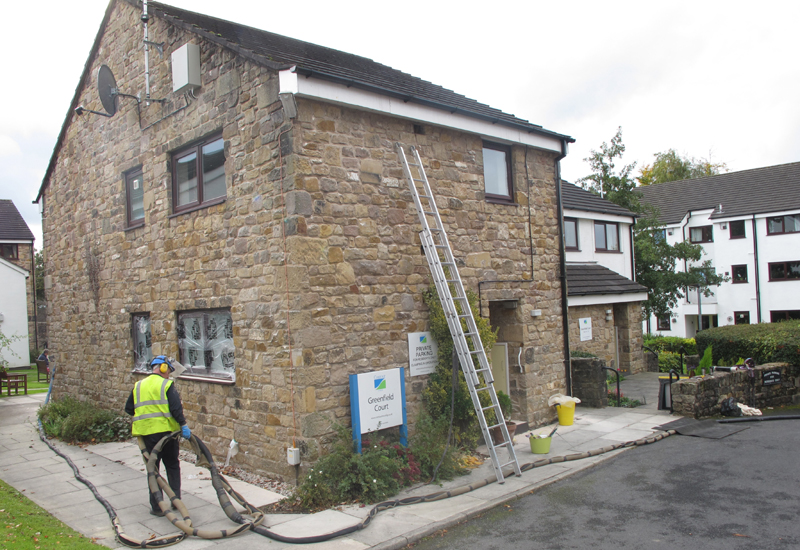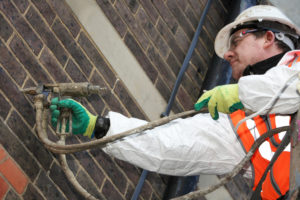
Leonie Onslow, executive director of the British Urethane Foam Contractors Association (BUFCA), discusses how the UK’s neglected ‘hard-to-treat’ social housing could be tackled with PU foam insulation.
Whilst the social housing sector has seen a substantial uplift in energy efficiency figures, hard-to-treat or non-standard housing has largely been neglected. It is these properties that are continually missing out on adequate insulation measures. Many of these properties were not insulated under previous government grant schemes — it is not acceptable that millions of householders with specialist problems or barriers to insulation should be excluded.
Energy efficiency figures have increased substantially over recent years and this is borne out by the reduction of homes failing to meet the Decent Homes Standard. In 2014, 4.6 million homes failed to meet the standard, but this figure has reduced by three million since 2006. Much of the increase is down to the availability of grant schemes for the insulation of standard housing and the willingness of the social housing sector to improve its energy efficiency.
 The 2016 ‘English Housing Survey Headline Report for 2014-2015’ also reported that the social rented sector had the lowest incidence of non-decent homes at 14%, compared to the private rented sector with 29%. Social housing providers have certainly led the way in achieving far higher insulation levels right across their housing stock. All that is required now is a little help to understand what solutions are available to treat the remaining uninsulated houses.
The 2016 ‘English Housing Survey Headline Report for 2014-2015’ also reported that the social rented sector had the lowest incidence of non-decent homes at 14%, compared to the private rented sector with 29%. Social housing providers have certainly led the way in achieving far higher insulation levels right across their housing stock. All that is required now is a little help to understand what solutions are available to treat the remaining uninsulated houses.
Housing classification
Hard-to-treat housing may be classified as such for a number of reasons. These could be properties with narrow cavities, stone cavities, failing wall ties, or a metal frame or timber framed construction. This normally means that the use of cheaper cavity wall insulants is not an option. Other reasons could be where internal wall insulation may disrupt tenants, or properties located in high or severe wind driven rain exposure conditions, or where properties are at risk of flooding.
A high proportion of occupiers in hard-to-treat housing are classified as being in fuel poverty and social housing providers are required by law to tackle this problem. This is set out in the Government’s Fuel poverty strategy and came into force in December 2014. As many houses as possible are required to meet a minimum standard of energy efficiency, at Band C, as reasonably possible by 2030.
If all homes were brought up to a decent standard of energy efficiency this would also relieve some of the pressure on hospitals both in terms of admissions and the resultant cost savings for the NHS. There is a high correlation between cold-related hospital admissions and those living in fuel poverty.
Closed-cell insulation
The British Urethane Foam Contractors Association (BUFCA) represents the sprayed and injected polyurethane foam industry. The association advocates the use of polyurethane as a solution for improving the energy efficiency of the 4.7 million hard-to-treat cavity homes. It is likely to be the most cost-effective long-term solution for tackling high domestic energy bills and eradicating fuel poverty. Social housing providers are in a key position to achieve this.
 Spray-applied or injected polyurethane foam can easily be used for wall and roof insulation to effectively insulate most housing. The two-component liquid system produces a highly-efficient blanket of insulation with a thermal conductivity approximately twice as efficient as fibreglass. It is particularly cost-effective and easy to apply to a wide variety of substrates. Its closed-cell nature renders it very resistant to moisture ingress.
Spray-applied or injected polyurethane foam can easily be used for wall and roof insulation to effectively insulate most housing. The two-component liquid system produces a highly-efficient blanket of insulation with a thermal conductivity approximately twice as efficient as fibreglass. It is particularly cost-effective and easy to apply to a wide variety of substrates. Its closed-cell nature renders it very resistant to moisture ingress.
For wall insulation, injected polyurethane foam can be used in the cavity to provide a superior performing insulant, which also helps to bond the inner and outer leaves providing strength to the building. Air leakage through the cavity can be reduced to zero. Because of the greater thermal performance and the reduced air leakage polyurethane foam outperforms all other forms of cavity fill.
Flood waters penetrate housing and cause much damage to the building substrate, the cavity wall ties and internally if it comes through to the inside. In the UK there are 5.2 million homes in flood risk areas. According to the Association of British Insurers at least £451m was spent by insurers on flood claims during the period of excessive rain between December 2013 and February 2014. By using a closed-cell cavity insulant an additional layer of resilience helps prevent flood water tracking through the cavity and damaging the structure internally. Closed cell materials retain their integrity and have low moisture take-up.
Stabilising roofs
Spray-applied foam can be used to insulate and stabilise roofs (for instance in cases of nail fatigue), or as an energy-efficient alternative to reroofing. It has been used to stabilise pitched roofs in under-tile applications for over 40 years. Spray applied foam used in lofts meets Class 1 Surface Spread of Flame when tested to BS 476: Part 7 and with the addition of a specialist coating, can achieve Class 0. Air leakage can be reduced down to zero with in-situ applied polyurethanes.
Where polyurethane foam insulation is applied to an existing roof this is subject to a site survey as the roof needs to be structurally sound prior to installation. A professional installer will undertake a survey and remedial works before spraying the insulant. Local authorities, housing associations and other social housing providers can find professional installers offering excellent advice and quality installations from the BUFCA website. Installers have to ensure that high standards are maintained and work to the association’s Code of Professional Practice.
There is a 25-year insurance warranty, which BUFCA installer  members can offer for hard-to-treat domestic injected polyurethane cavity wall insulation projects. The warranty offers reassurance to customers and becomes effective if there is a fault with the installation and the installer has ceased to trade or cannot honour the guarantee.
members can offer for hard-to-treat domestic injected polyurethane cavity wall insulation projects. The warranty offers reassurance to customers and becomes effective if there is a fault with the installation and the installer has ceased to trade or cannot honour the guarantee.
Hard-to-treat housing need not be a problem: it may be more expensive to treat but the resultant benefits to occupiers are enormous. The solution is normally quite simple if social housing providers work with installers who can effectively treat non-standard construction types — fuel poverty may soon be a thing of the past.








